Accomplishment of the Great East Japan Earthquake Mission
Introduction
At 14:46 JST on March 11, 2011, a major earthquake occurred that measured magnitude 9.0, making it the largest observed in Japanese history.
The powerful tsunami triggered by the earthquake caused massive and extensive damage by submerging settlements along the Pacific coastlines of Iwate, Miyagi and Fukushima prefectures including the nuclear reactors of Tokyo Electric Power Company’s Fukushima Daiichi Nuclear Power Station which developed radiation leaks.
I express my sincere condolences to the families of those who were killed in the earthquake and sympathies to those who were affected.
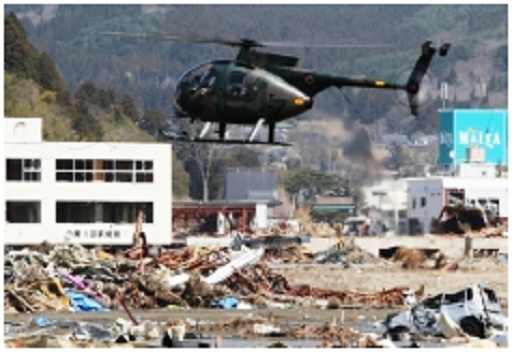
I also express my sincere appreciation to every aviation unit around Japan and everyone around the world, including the members of the U.S. Forces, who rushed into the affected area in the wake of disaster.
As the commander of Northeastern Army Aviation Group, I’m proud to report to all of you that we have accomplished our disaster relief mission without any aviation accidents. What follows is my analysis of the reasons for our mission success and lessons learned during this operation.
Activities of JGSDF
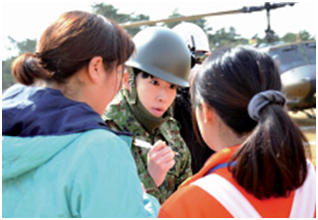
In order to strengthen activities in the devastated area, the Joint Task Force for the Great East Earthquake was formed under the Commanding General of Northeastern Army, Japan Ground Self Defense Forces (JGSDF) and included forces from the Yokosuka Commanding General, Japan Maritime Self Defense Forces (JMSDF) and the Air Defense Commander, Japan Air Defense Forces (JASDF).
Approximately 500 members, mainly from JGSDF’s Central NBC Weapon Defense Unit and others coming from JMSDF and JASDF were mobilized specifically for the nuclear disaster.
When numbers were at their largest, they reached approximately 107,000 members of Japan Self Defense Forces (JSDF), including ready reserves and regular reserves, and approximately 540 aircraft and 60 vessels.
Activities of the U.S. and other forces
U.S. Forces named its humanitarian assistance and disaster relief operation “Operation Tomodachi (friends),” and mobilized approximately 16,000 personnel, 15 vessels and about 140 aircraft.
They conducted large-scale support activities including search and rescue, transporting supplies, restoration of Sendai Airport, clean-up of school buildings in preparation for the new school term, removing rubble in Kesennuma Ohshima, and joint concentrated searches for missing people.
The Australian Defense force (ADF), the Republic of Korea (ROK), the Royal Thai Armed Forces, the Israel Defense Forces and the French Ministry of Defense dispatched their personnel and equipment and conducted numerous support missions including air-transportation of supplies.
JGSDF’s aircraft and its operation
In the earthquake disaster relief mission, JGSDF aircraft were used for lifesaving missions at first, and then for various missions such as searching for missing persons and the aerial transport of assistance to isolated areas.
Moreover, for the nuclear disaster relief mission, CH-47s from the 1st Helicopter Brigade, JGSDF were employed to drop water on Unit 3 of the Fukushima Daiichi Nuclear Power Station plant No.3 machine using aerial firefighting equipment.
Great efforts of the aviation personnel
The soldiers of Northeastern Army Aviation Group, despite being personally affected by the earthquake, accomplished their mission to the full extent of their abilities from the beginning of the disaster to completion thereby regaining the brightness of Michinoku (the Thoku region of Japan).
And the strong support of aviation units from all over Japan was extremely helpful as well.
Every soldier exerted around-the-clock efforts.
Northeastern Army Aviation Group was augmented to a large extent by the units from all around Japan.
Their numbers and outstanding spirit filled me with courage.
I’m proud of aviation personnel who devoted themselves to their activities and thankful especially to the reinforcement units all over Japan for their assistance to us and the victims, because we could have accomplished nothing without their help.
Importance of military airfields and camps as strong points

There is a shrine called “Namiwake (which means wave-divide) Shrine” about a quarter mile toward the coast from Camp Kasuminome, a JGSDF camp for Northeastern Army Aviation Group in Sendai City.
This shrine had been erected at the time of an ancient tsunami disaster to commemorate the point where the tidal waves reached.
Kasuminome airfield in the camp was not affected by the tidal waves because it was on the land-side of the shrine.
Additional protection from the tidal wave was provided by the banked structure of “Sendai East Highway” which had been constructed in 1994 and runs parallel to the coast, about 2 miles away from the camp .
Because Sendai Airport, a civilian airport located south-east of Sendai city, and Matushima Airbase, a JASDF base located north-east of Sendai city, were severely damaged by the tidal waves, nearby Kasuminome airfield, a small airfield with only 2,300 feet runway, became a major rally point for the disaster relief mission.
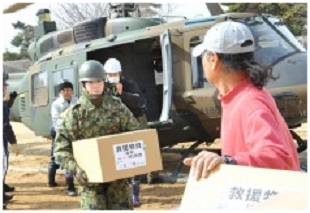
Thus, an incredible number of helicopters belonging to JSDF aviation units, Japan Coast Guard, Fire Department, U. S. Forces, other government offices and civilian organizations were assembled at Kasuminome airfield for parking, refueling and maintenance.
Some medical treatment facilities including staging care units (SCU) were established at the temporary shelters constructed on Kasuminome airfield and were filled with many military medics and civilian medical personnel for disaster relief mission.
The facilities of Camp Kasuminome were also utilized as temporary evacuation centers for refugees from neighboring areas and survivors who were rescued by helicopters.
We also provided bathing facilities for the disaster victims and supplied gasoline for civilian public institutions.
The disaster relief mission highlighted the importance of military facilities as strong points for its activity.
The military camps and airfields must be maintained even in a fiscally constrained environment.
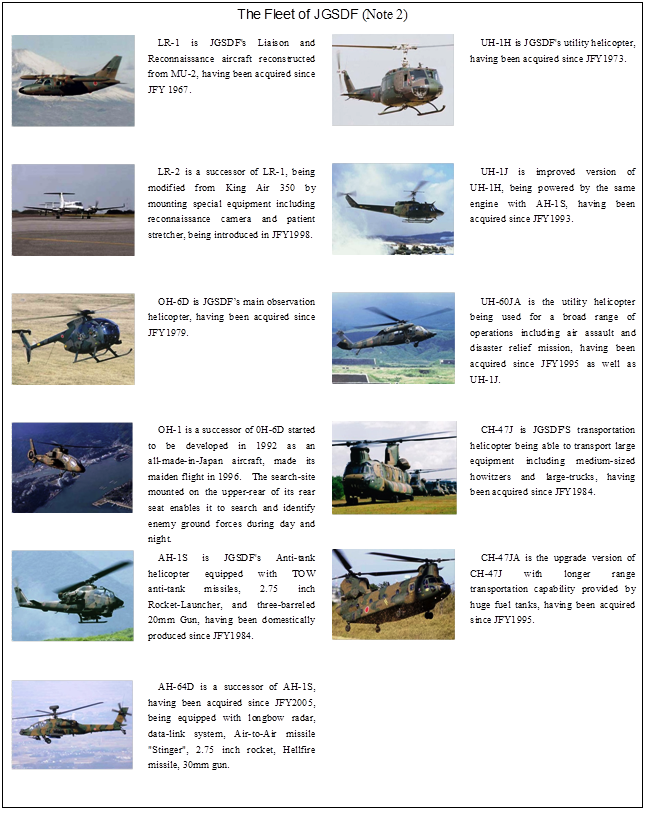
Importance of equipment, training and mettle
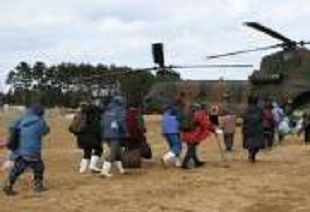
The night of March 11th was exceptionally dark because of the electric power failures and thick clouds.
The helicopters of organizations other than JGSDF could not conduct any rescue mission because they lacked night vision devices to see terrain features and could not approach buildings.
The JGSDF’s helicopters could conduct the rescue mission because they were equipped with night vision goggles, the crews were trained for rescue activities including hoist operations, and each crew had the mettle that said, “If not me, then who-”
The main factors that allowed us to achieve our mission were our sophisticated equipment, our rigorous training, and our strong mettle.
“To train ourselves as if we were on an actual mission,” and “to conduct actual missions as we would in training” are important for us to accomplish our mission and maintain our mettle.
Leadership as the group commander
During the disaster relief mission, I required my subordinates “to be bright and energetic” and “to be flexible.”
“To be bright and energetic” required my subordinates to find ways to fulfill their mission, even in the most severe situation.
At the end of each daily briefing, I always concluded with the words “Let’s be bright and energetic all day again today.”
The-words “To be flexible” required them to find a way to deal with every mission without quitting; that even the missions with low probability of success must be re-considered and accomplished in other ways or by other means.
Especially, in the case of rescue tasks, the aircraft must take-off as soon as possible, even if the task itself might be canceled by the confusion at the beginning of disaster.
I always said, “If not me, then who-” and “If not now, then when-” in order to keep my subordinates’ mettle high.
I also warned them to make weather decisions carefully before and during the flight, and not to hesitate to make a precautionary landing in the case of inadvertent instrument meteorological conditions.
Ensuring aviation safety
Very few unsafe conditions developed during this disaster relief mission, because all aviation personnel carried out their duties with high motivation, morale and concentration.
Their efforts to conduct missions quickly and surely enhanced aviation safety and avoid unsafe conditions.
Another factor that ensured our safety was that we always considered the basics and fundamentals as an important part of aviation safety.
These basics and fundamentals enabled us to act in safe ways and avoid unsafe conditions even under the uncertain situations which often occurred during this disaster relief mission.
The fact that Kasuminome airfield control tower achieved 10,000 aircraft movements on June 20, 2011 in only 102 days since the wake of disaster, was another validation of our efforts in aviation safety.
As an aviation safety special staff officer of Northeastern Army, I visited the deployment areas of my subordinate units to confirm safety conditions and encouraged my subordinates who were working under severe circumstances in unfamiliar territory.
Conclusion
It is my great pleasure that we successfully completed all missions in the face of this catastrophe and in such a way as to be worthy of being remembered for all posterity.
I express my heartfelt gratitude and share the satisfaction with all of you of achieving this most worthwhile mission.
COL Araseki(ret.) is the commander of Northeastern Army Aviation Group, JGSDF who served as the commander of augmented Northeastern Army Aviation Group under the command of Joint Task Force Commander organized to conduct disaster relief operations following the Great East Japan Earthquake.
Translation by MAJ Kenji Kagemoto, Northern Army Aviation Group, JGSDF
出典:ARMY AVIATION, Army Aviation Association of America 2012年05月
アクセス回数:4,505
コメント投稿フォーム
2件のコメント
Army Aviation誌に掲載された「東日本大震災災害濱遣活動に参加して」の原文です。
米国(世界)に発信するのにふさわしい記事があれば、ぜひ、また英訳して投稿したいと思っています